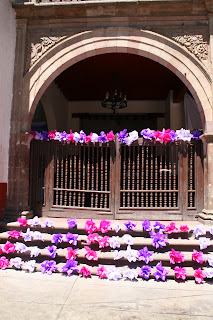 When I was at my home in San Miguel de Allende, I went over to Patzcuaro for a few days. The first morning we drove a short half hour over to Santa Clare de Cobre. After a delicious breakfast at the Camino Real (no relationship with the big chain in Mexico), we were headed back to the center of town to check out one of the stores noted for their copper. I slowed the car down and shot this photo of this cute little girl in a butcher shop.
When I was at my home in San Miguel de Allende, I went over to Patzcuaro for a few days. The first morning we drove a short half hour over to Santa Clare de Cobre. After a delicious breakfast at the Camino Real (no relationship with the big chain in Mexico), we were headed back to the center of town to check out one of the stores noted for their copper. I slowed the car down and shot this photo of this cute little girl in a butcher shop.I may be the only one in the family who is fascinated by the pig heads that are sale in the market. This particular one was in the open market in Patzcuaro.
This guy (or girl) was on display with some Spanish chorizo in the market in Santiago de Compastella in the northern state of Galicia in Spain. Spanish cuisine has influenced my cooking tremendously. My husband, Len and I love to dine on Cochinillo (roasted suckling pig) and also Cabrito (roasted suckling goat).
Due to FDA regulations in the states, you can not purchase suckling pigs (piglets that are still nursing). Unfortunately I am not friendly with any local farmer that raises pigs. I did how ever order a small pig from an outfit north of Phoenix which weighed 14 pounds. I really would have preferred an eight pounder but I guess that would entail another trip to Spain. I had the piglet in a salt water brine for 24 hours before roasting it. It was a bit strange to open the refrigerator. He took up the entire shelf and he seemed to be giving me the evil eye. I had to buy a roasting pan to accommodate the length of the piglet and to fit in my Thermador range which thankfully has a huge oven. It was a perfect fit with not much room to spare. It turned out perfectly cooked, nice and tender but the flavor was a bit too gamy for my taste, not as delicious as the Cohinillos in Spain. Oh well, it's just another reason to make another trip back to Barcelona.























































